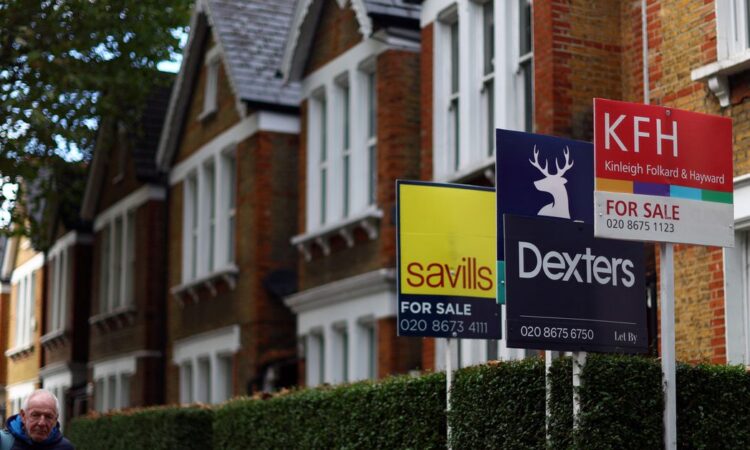
[1/2]A man walks past houses ‘For Sale’ in a residential street in London, Britain, September 27, 2022. REUTERS/Hannah McKay
LONDON, July 11 (Reuters) – A key British mortgage rate hit a 15-year high on Tuesday when it rose above the levels reached in the aftermath of September’s “mini-budget” crisis, adding to strains on the country’s slowing housing market as the Bank of England battles stubborn inflation.
The average two-year fixed residential mortgage rate climbed to 6.66%, narrowly exceeding the 6.65% touched on Oct. 20 and the highest since August 2008 when it stood at 6.94%, according to data provider Moneyfacts.
Britain’s housing market activity staged a recovery in early 2023 from the turmoil triggered by the unfunded tax-cutting plans of former Prime Minister Liz Truss. But homeowners and buyers have faced renewed mortgage pain in recent months.
Fixed mortgage deal rates have risen rapidly in recent weeks as stickier-than-expected consumer price inflation, which held at 8.7% in May, pushed up bond yields and increased market bets on the BoE’s benchmark rate peaking at 6.5%, up from 5% now.
Governor Andrew Bailey said last month there were signs of more persistent underlying inflation pressures after the BoE unexpectedly raised its Bank Rate to 5% in an effort to tame the highest inflation rate among the world’s big rich economies.
Swap rates, a key measure lenders use to determine the cost of mortgage borrowing, have also soared. Two-year swaps jumped by 0.89 percentage points over the course of June.
The surge has prompted major mortgage lenders to repeatedly reprice home loan offerings.
Lenders including Nationwide, Lloyds Bank and Santander on Tuesday told lawmakers on the Treasury Committee in Britain’s parliament that mortgage payment arrears had increased slightly but remained below pre-pandemic levels.
“Undoubtedly, households and customers are feeling the effect of not just mortgage rates increasing but the wider cost of living crisis … but arrears remain very low in a historical context, and still below what we’d have seen pre-COVID,” Andrew Asaam, homes director at Lloyds Banking Group told lawmakers.
However, most households have yet to face the impact of higher borrowing costs as they are still locked in to previous deals.
British homebuyers typically take out mortgages with an interest rate that is fixed for two or five years, and then remortgage on to a new fixed rate or accept a variable rate.
Trade body UK Finance estimates 800,000 Britons will need to refinance loans in the second half of this year, and a further 1.6 million in 2024 of a total of nearly 7 million fixed-rate mortgages that are outstanding.
Analysis from the Resolution Foundation, a think tank, shows the average homeowner who refinances a home loan in 2024 will have to pay an extra 2,900 pounds ($3,732.88) a year.
House prices have also shown the hit to the market. Mortgage lender Halifax reported a 2.6% annual fall in house prices in June, the largest decline since 2011, while Nationwide reported a 3.5% drop year-on-year last month, the biggest since 2009.
($1 = 0.7769 pounds)
Reporting by Suban Adbulla and Sachin Ravikumar; Editing by William Schomberg, Kate Holton and Andy Bruce
Our Standards: The Thomson Reuters Trust Principles.






